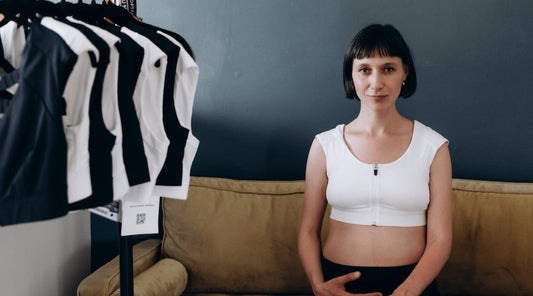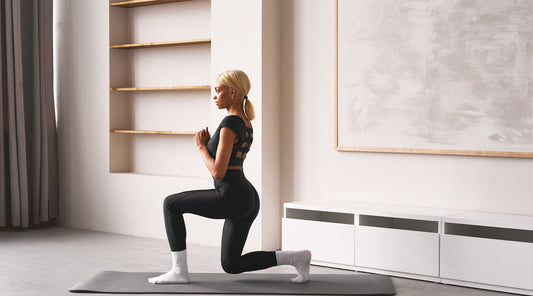As our collective posture seems to droop ever further south, the market has responded with a seemingly endless selection of posture correctors. You can get an old-school back brace, sleek posture-correcting shirt, stylish posture bra, or even a high-tech device that “shocks” you into place.
The effectiveness of posture correcting devices will vary depending on the design and quality of the corrector as well as the shape and needs of the person wearing it. Most posture correctors focus on adjusting the shoulders and repositioning the neck and back to help bring the spine into a natural, neutral alignment. This can help fix forward head position — when the head juts forward and the shoulders round down — and other common posture problems.
Below, learn more about the benefits of wearing a posture corrector, how to determine if you need one, and how to choose the best one for you.
Overview of posture correcting devices
Back posture correctors come in various shapes and styles. Each works a little differently to focus on the weak areas around your shoulders, cervicothoracic junction (where the neck meets the upper back), or lumbar spine (the lower back).
Back braces
When you think of a posture corrector, a back brace or orthopedic corset may be the first thing that comes to mind. Some back braces wrap around your torso with velcro while others may feature over-the-shoulder straps or crossed-back laces. You typically wear these types of braces over your clothes.
Depending on the style, back braces can target different areas. They may offer lumbar support — which is helpful if you tend to arch your back — or help to pull your shoulders back to improve posture and relieve pain in the upper and mid-back. One study in athletes found that back braces were effective in improving posture and shoulder muscle function (1).

Posture-correcting shirts
A posture-correcting shirt may be more practical, at least when it comes to style. This type of form-fitting apparel is designed to improve your upper body alignment by activating key postural muscle groups. The fabric around the shoulders remains tight to keep your shoulders upright and your diaphragm open. Studies on posture-correcting shirts are a mixed bag. One review found that they can have a positive effect on comfort, energy, and productivity levels, but that there was a high risk for bias among most of the studies (2).
Tech-powered posture correctors
High-tech posture devices are also becoming increasingly popular. This wearable technology is small and lightweight and may be paired with an app. Using movement sensors, they can record your posture, monitor changes in your body alignment, and buzz or vibrate when you start to slouch.
These types of “smart” posture correctors can be effective if you want to track your posture throughout the day. The vibrational reminders can also keep you (literally) in line. While there is some early evidence that shows tech-powered posture correctors can help motivate users to sit up straight, there’s little research to support their effectiveness on actual posture (3).

Posture bras
Posture bras offer a more covert way to correct your posture. These can be worn under your clothes or — like with the Etalon posture correcting bra — as their own fashion statement. Posture bras typically work by gently pulling your shoulders back to help you open your chest and prevent slouching.
This type of functional apparel can be worn during any activity to better your posture and form. One study found that participants wearing a posture bra for three months improved their scapula (shoulder blade) position, reducing the risk of pain associated with poor posture (4).

How posture correctors work
Posture correctors address muscle imbalances caused by poor posture. They help activate the weak, overstretched muscles in the back of the shoulders and upper back. At the same time, they help stretch the tight, shortened muscles in the front of the shoulders and chest. Some posture correctors also help reduce pressure in the lower back.
Think of a posture corrector as a training tool. When worn consistently, it builds muscle memory and improves your proprioception (your awareness of the position of your body) so that you can more naturally settle into your ideal alignment.
Who should wear a posture corrector?
Anyone can wear a posture corrector. The key is to find one that works best for your body, is comfortable, and addresses your needs.
You may want to try a posture corrector if you:
- Sit or stand for long periods of time
- Find yourself slouching or slumping over often
- Experience neck, shoulder, or back pain
- Struggle to maintain good form while exercising
- Suffer from tension headaches (which can be triggered by tight muscles in the neck, shoulders, or upper back)
- Have digestive issues (which can worsen from poor posture)
When picking a posture corrector, choose one that targets your weakest areas. For example, if you often hunch your shoulders, try one that keeps your shoulders down and back, like the Etalon posture correcting bra.
How long should you wear a posture corrector?
There’s no set time frame for posture correction and every person will be starting from a different place. In general, we’ve found that new postural habits can take about three weeks to form and three months to stabilize. You’ll get the most out of the posture corrector if you track your progress week to week.
When wearing a posture corrector for the first time, you should feel it gently tugging you into an upright position. This may take some time to get used to. Aim to wear the posture corrector for up to one or two hours at a time. Increase that time period as you feel more comfortable with it. Give yourself breaks so that you can feel the difference in your body without the added support.
For the best results, wear your posture corrector daily, for up to around six hours a day. Take it off before you go to bed so as not to disrupt your sleep. Incorporate posture-promoting stretches and exercises as well. The Etalon Posture Bands can help keep you on task.
Benefits of using posture correcting devices
Back posture corrector benefits will vary, depending on the product and your commitment. If you wear one properly and consistently, you’ll start to see improvements in both your posture and overall well-being.
Here are some common benefits of a posture corrector:
- Eases and prevents pain in the neck, shoulders, and back
- Takes stress off joints and muscles that are overworked due to poor posture
- Reduces risk of tension headaches caused by tight neck muscles
- Helps you breathe easier (better posture allows your lungs to fill to capacity)
- Improves digestion (good posture opens up the diaphragm and allows the organs to work optimally)
You may also find that as your posture improves, you’ll feel more confident and productive.
Potential drawbacks and limitations
Have you heard that posture correctors can cause dependency and even weaken your postural muscles? This is a common belief that actually has no scientific proof.
Posture correctors are typically not harmful, but you do want to make sure you are wearing one that is comfortable and fits your body. A posture corrector shouldn’t cause you pain or restrict your movement. The best options for correcting posture are customizable, like the Etalon Posture Bra, which has adjustable straps that allow you to increase or decrease the support.
The best posture correctors actually work to strengthen overstretched muscles, improve your muscle memory, and train your body to find good alignment naturally.
Tips for choosing and using posture correcting devices
When choosing a posture corrector, first take note of your current posture. Do you have a flat back or increased curves in the neck or lower back? Do you often jut your head forward? Take the Etalon's posture quiz to find out which posture correcting bra may suit your needs and how a posture corrector can help.
Your posture corrector should fit you comfortably, address your specific needs, and be made with high-quality materials that won’t irritate your skin.
To reap the most benefits out of your posture corrector, wear it consistently. We recommend using a posture corrector daily — for up to six hours a day, for at least three months — but taking breaks from it, too. The point is not to rely on the device but to use it as a tool to help you find better posture on your own.
SOURCES
- Journal of athletic training. Scapular bracing and alteration of posture and muscle activity in overhead athletes with poor posture. https://www.ncbi.nlm.nih.gov/pmc/articles/PMC3554027/
- Scandinavian journal of pain. The use of posture-correcting shirts for managing musculoskeletal pain is not supported by current evidence - a scoping review of the literature. https://pubmed.ncbi.nlm.nih.gov/31075089/
- Sensors. Commercial Postural Devices: A Review. https://www.ncbi.nlm.nih.gov/pmc/articles/PMC6929158/
- Gait & posture. A novel multi-study intervention investigating the short and long term effects of a posture bra on whole body and breast kinematics. https://pubmed.ncbi.nlm.nih.gov/33161276/
FAQs
What types of posture correcting devices are available on the market?
What factors influence the effectiveness of posture correction devices?
How long should I wear a posture corrector?
What are signs of bad posture?
Trending
Try Etalon posture improvement products









